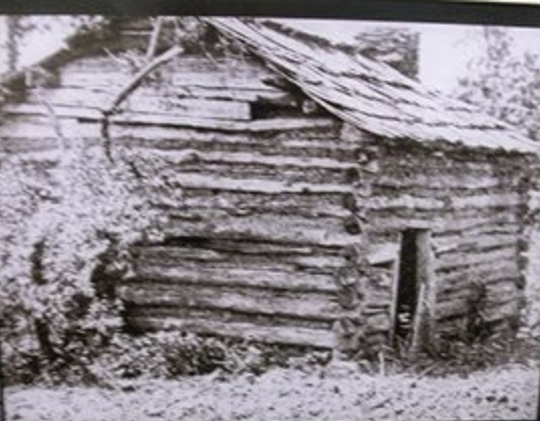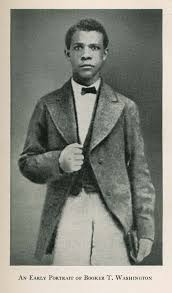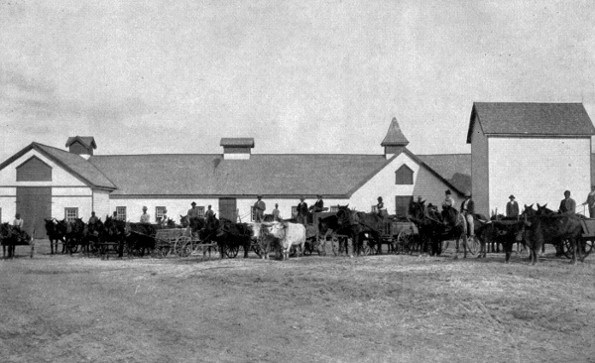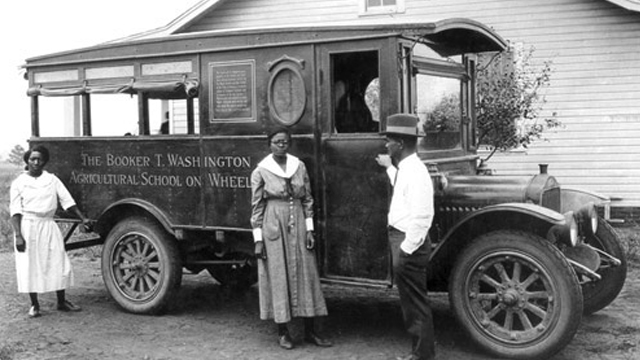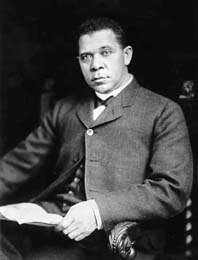| Today, April 5, is the birthday of Booker T. Washington. If the New Farmers of America (NFA) still existed, we would be celebrating National NFA week. Just as the FFA celebrated National FFA week during George Washington’s birthday, the NFA celebrated National NFA week during Booker T. Washington’s birthday.
Last week, the Friday Footnote looked at the connection between George Washington and the FFA (thanks to Dr. Connors). This week we will explore the connection between Booker T. Washington and the NFA. How much do you know about Booker T. Washington and his connection to agriculture? Most of us know he was an African-American leader and was connected to Tuskegee University, but other than that, we don’t know much. Part of the opening ceremony of the NFA went like this: Vice-President: The Treasurer Swift and Company provided framed photographs of Booker T. Washington and H. O. Sargent to NFA chapters for use in the opening ceremony. One of the three national NFA sections was the Booker T. Washington Section. This Section was comprised of Delaware, Maryland, North Carolina, South Carolina, and Virginia. Before you proceed any further, please open the Booker T. Washington Quiz and take it. The answers will be provided in this Footnote. Young Booker T. Washington Booker was born into slavery April 5, probably in 1856 (but the year is not 100% certain). He was born on the Burroughs farm in Hale’s Ford, Virginia to Jane, the cook. The cabin in which he lived also served as a kitchen and the floor was dirt. It is not known who his father was. For his entire childhood, he was simply known as Booker. The farm had 207 acres of which 107 were tillable. The main residence, a log house covered with weatherboarding, had only five rooms, three downstairs and two in the half story under the roof. The Burroughs family have five girls and two boys. Tobacco, wheat, corn, and oats were grown on the farm. There were 4 horses, 4 milk cows, 5 beef cows 12 sheep and 16 hogs according to the 1860 Agricultural Census. There were six adult slaves and two one-room slave cabins. Figure 1 shows the structure in which Booker lived as a child.
Figure 1: The childhood home of Booker T. Washington During his childhood, Booker carried water to the other slaves, operated a fan on a pulley to shoo away flies while the “master” and his family ate, and toted sacks of corn to the mill. Sometimes he accompanied the daughter of his owner to school so he could bring back the horse for the day’s work. He had no schooling and never had a sit-down meal with his family. When Booker was nine years old the Civil War ended (1865) and slaves were freed. He moved with his mother to join his step-father in Malden, West Virginia (near Charleston). He started working in the salt furnaces at the age of 9. Brine was boiled down to make commercial salt. Booker packed the crystallized salt into barrels. An educated Negro from Ohio moved to the area and started a “pay” school. Booker was very disappointed when his stepfather did not allow him to go to school; needed him to work instead. The teacher consented to give some lessons to Booker at night Finally, Booker’s stepfather “relented” to let Booker attend school provided that he first work from 4 am to 9 am at the salt furnace, go to school, then come back and work for two more hours after school. On the first day of school, he realized all the other students had two names, so when asked, he said Booker Washington. He later learned that his mother had named him Booker Taliaferro at birth. Because of work demands, Booker attended school irregularly and finally stopped to work full time. He resorted to finding someone to teach him at night. Then Booker started working in a coal mine (mining coal to fuel the salt furnaces). One day he heard two miners talking about a wonderful school in Hampton, Virginia for” coloured people”. While he had no idea how far away that was, from this point on, going to Hampton was his driving ambition. Soon after learning about Hampton, Booker is hired as a houseboy to Mrs. Viola Ruffner whose husband (General Ruffner) owns the mine and salt furnace. She is very demanding and wants everything clean, done promptly and systematically, expects frankness and honesty and does not tolerate slovenly or slipshod work. Booker and Mrs. Ruffner get along well. He works 1 ½ years for her and learns much. At the age of 16 Booker starts the journey to Hampton. First by train, then stagecoach, then walking and hitchhiking. During his journey, he experienced racial discrimination for the first time and is shocked. He finally reaches Richmond, out of money and hungry. He then works odd jobs and finally reaches Hampton. He is filthy and his clothes are in tatters when he arrives at Hampton. As soon a Booker arrives at Hampton, he finds the “admission officer” and inquires about enrolling. She is put off by Booker’s rough, dirty appearance and tells Booker to wait as she works with others seeking admission. Finally, after seeing that he was not going to leave, she conducts the admission exam. The “exam” is to clean an adjacent room. He cleaned it three times and was confident that it was clean enough to pass because it would have satisfied Mrs. Ruffner. The admissions officer was impressed and admitted Booker. Hampton Institute was basically a high school that emphasized learning a trade. It was founded by a white person, General Samuel Chapman Armstrong. After the Civil War Armstrong was moved by seeing freed slaves sitting by the road not knowing what to do next. So, he started the school. Manual labor and school work went hand in hand. Booker graduated in three years (in 1875) with a diploma (honors) and a certification that allowed him to teach school. He was 19 years of age. He returned to Malden, WV and teaches school. He also conducts a night school for adults.
Figure 2: Booker at the time of his graduation from Hampton. Booker is asked to return to Hampton to be a teacher in 1879. He has responsibility for the night school. He is also is the dorm father for 50 Native Americans who had been captured in fighting out west. The school leaders believed his background would prepare him to “civilize” this group. General Armstrong received a request (May 27, 1881) to recommend a white person to go to Alabama and lead a new school that is to be patterned after the Hampton model. Armstrong recommends Washington even though he is not a white person. The Alabama folks agree. So, at age 25 Booker goes to Alabama to lead this school. He arrives on June 24, 1881. The Story behind Tuskegee In 1880 Colonel Wilbur Foster was running for reelection to the Alabama Senate and Arthur Brooks was running for reelection to the House. They went to see Lewis Adams, the leading Negro citizen in the village of Tuskegee and asked his price for swaying the black vote. What was Adams’ price? He wanted a normal school (a school that prepares teachers) for Negroes to be established in Tuskegee, Alabama. The Negro voters rallied behind Mr. Adams and the incumbents retained their seats in the State Legislature. After the election Mr. Brooks kept his word and introduced a bill that the Governor signed on February 12, 1881, to establish the Tuskegee State Normal School for colored teachers with an annual budget of $2,000. BUT all the money for schools had already been spent for the budget year—so no funds would be available until October. When Booker arrived on June 24, 1881 to head up the school, he found nothing – absolutely nothing! But Mr. Washington was not deterred. He started teaching a class of 30 students in a shanty next to an abandoned church on July 4, 1881 (note the significance of July 4). Because there was no land or facilities it would be hard to immediately implement the Hampton model. During the first few weeks, Washington traveled the surrounding area to learn more about the people, their way of life, the problems, etc. He interacted with both the white people and the Negroes. After getting the “lay-of-the-land” he contacted Hampton and asked for a $500 loan to buy a 100-acre farm that had three buildings on it — a kitchen/cabin, a stable and a chicken house. See Figure 3. Classes were first held in the chicken house.
Figure 3: The Original Tuskegee Campus Immediately after taking possession of the farm, students began to clear land. Enrollment climbed – 60 in September, 81 in November. Washington recruited additional teachers; primarily from Hampton. The fledgling institute was up and running. However, raising funds was a constant concern. In the early days, there were door to door solicitations, benefit suppers, and Tuskegee students provided “literary entertainment” at community events. Later there were contributions from supporters (primarily well-to-do families in the north) and the Slater and Peabody funds. After the Institution was firmly established, Washington spent about 1/3 of his time traveling and speaking in the North to raise funds to support Tuskegee. The students built nearly every building on campus. It took some experimenting but they learned how to make quality bricks which were used in the buildings. As buildings were erected, the full-blown Hampton model was slowly implemented.  Figure 4: Tuskegee students building the campus Farming classes were taught along with sewing and tailoring and general education subjects such as philosophy and history. Teachers were also prepared at Tuskegee.
Figure 5: At the school farm getting ready for a day’s work
Figure 6: Tuskegee students learning to prune peach trees Tuskegee Reaches Out Under Washington’s guidance, a multitude of outreach activities were started to benefit the farmers, teachers, ministers, communities, and others. Some of the activities started at Tuskegee were: · 1884 – Teacher’s Institute Washington encouraged his faculty to “take their teaching into the community.” George Washington Carver, who was a faculty member at Tuskegee, responded by designing a “movable school”. The first “movable school” was a horse-drawn wagon called a Jesup Agricultural Wagon. It hit the road in 1906. Later it was a mechanized truck but was still called a Jesup Wagon. It was used to instruct farmers and sharecroppers in rural regions of the state about efficient farming methods. It was a common sight at county fairs and community gatherings. The wagon was named for Morris K. Jesup, a New York financier who gave Washington the money to equip and operate the “movable school”, including the purchase of the mules that pulled the wagon.
Figure 7: The Jesup Agricultural Wagon By 1930, the “Booker T. Washington Agricultural School on Wheels” carried a nurse, a home demonstration agent, an agricultural agent, and an architect to share the latest techniques with rural people. The “movable school” was the cornerstone of Tuskegee’s extension services and epitomized the Institute’s doctrines of self-sufficiency and self-improvement.
Figure 8: A mechanized Jesup Wagon Booker teamed up with Julius Rosenwald, the President of Sears-Roebuck, to build improved schools for black children in the South. The idea was Washington’s but the financing came from Rosenwald using a matching grant approach. Tuskegee students designed the schools and prepared the blueprints. The schools were to have a special industrial room where girls were to be taught sewing and cooking and the boys farming and the use of tools. There was also to be land for farming experiments and gardens. Many of these schools had vocational agriculture programs and chapters of the New Farmers of America. Over 5,000 Rosenwald Schools were built. For more information about Rosenwald Schools see the Friday Footnote for 9/17/2018. The End In the fall of 1915 Washington was in poor health. He was suffering from headaches, fatigue, weight loss, and failing vision. In November of 1915, his health was rapidly deteriorating. He was in New York and saw two doctors who both agreed his death was imminent. Upon learning that he only had a few days left to live, Washington expressed a desire to die at Tuskegee. He boarded a train for Tuskegee on November 12. He arrived in Tuskegee shortly after midnight on November 14, 1915. He died a few hours later at the age of 59. He was buried on the campus of Tuskegee University. Overwork couple with high blood pressure contributed to his death. Eight thousand people turned out for Washington’s funeral; many of them poor and uneducated. Some had walked for miles to attend. All the stores in the town of Tuskegee were closed during the funeral. Fisher (1915) tells of one occurrence at the funeral: One old couple, themselves near the sunset of life, walked a long, long distance to be here. Piteously, the man approached one of the instructors and with trembling lips and eyes that overflowed asked: “Do you reckon they will let us see Booker?” and he hurried to explain: “We have come so fur jes’ to see him de las’ time. Do you reckon they will mind us looking at him?” They were especially escorted to the casket and given their heart’s desire; for Dr. Washington’s love for them when he was here cannot be described. Conclusion Booker T. Washington demonstrated the power of persistence and having a vision. Then he demonstrated that hard work could help achieve that vision. He was a strong advocate for vocational and extension education. Under his leadership, Tuskegee started extension activities for farmers and vocational agriculture programs in the schools. Washington rose from humble beginnings to national prominence. My favorite Washington quote is “A man’s position in life is not measured by the heights which he has attained, but by the depths from which he has come.“ If Booker T. Washington could rise from slavery to accomplish what he did, there really is no excuse for us not accomplishing more in our lives. Andrew Carnegie, a leading industrialist in the late 1800s said this about Booker T. Washington “The modern Moses, who leads his race and lifts it through education . . . History is to know two Washingtons, one white, the other black, both Fathers of their People.”
Teaching Ideas This material about Booker T. Washington could be used in a variety of teaching units ranging from agricultural history, educational history, character building and goal setting, FFA & NFA History, etc. Use your imagination. Some possible ideas and resources follow: 1. There is a 30-minute public domain film about Washington that could be used with your classes. 2. I have compiled a two-page document containing quotes from Washington. Distribute it to your students and have them pick their favorite quote and tell why. BTW Quotations 3. W. E. B. Dubois was not in favor of the type of education espoused by Washington. He wanted a more liberal arts education. Have your students conduct research on the educational views of Washington and Dubois and compare and contrast them. Which approach do your students support? 4. Washington gained national prominence when he spoke at the Cotton States Exposition in Atlanta in 1895. This exposition attracted 800,000 visitors and was designed to promote the South and interest new trading partners. The speech was titled “Cast Down Your Bucket Where You Are” and implored blacks and whites to work together in harmony. A famous line from the speech is “In all things that are purely social we can be as separate as the fingers, yet one as the hand in all things essential to mutual progress.” A transcript of the speech and an audio recording can be accessed at http://historymatters.gmu.edu/d/88/. You might have your students listen to the audio or read the transcript and react to it. 5. I have created a PowerPoint presentation about Booker T. Washington that could be downloaded and used. However, it is IMPERATIVE that you first review the presentation and hide materials that you do not want your students to see. In 2015 (the 100th anniversary of Washington’s death), I spoke at the Chautauqua Institution in New York State about Mr. Washington (Washington spoke here on four different occasions – 1896, 1902, 1906, 1909). On a typical day in the summer, there are 7,500 people in attendance at Chautauqua. The people who attend Chautauqua are typically older, well-educated adults who want to be mentally stimulated. That is what I attempted to do. The title used for the presentation was “Booker T. Washington: Savior of His Race or a Traitor??” This PowerPoint was used for that presentation. In the Chautauqua presentation, I discussed most of the materials contained in this Footnote plus some of the controversies surrounding Washington. Several prominent black leaders (such as Dubois, Trotter, and Morris) were very critical of the Cotton States Exposition speech. They thought Washington was too accommodating and passive in the speech. They labeled the speech “The Atlanta Compromise.” The greatest controversy of Washington’s career was in 1901 when he dined at the White House at the invitation of President Theodore Roosevelt. Newspapers and politicians in the South were outraged. This was the first time a black person had been invited to be a guest at the White House. Both Roosevelt and Washington received death threats because of this. The language used in the newspapers to describe the event could not be used today. The PowerPoint contains some of those quotes. References Fisher, Isaac (November 18, 1915). The Funeral of Booker T. Washington. http://btwsociety.org/library/honors/05.php Washington, Booker T. (1901). Up From Slavery: An Autobiography. New York. Doubleday. (Available online free from Google Books. Most of the material in this Footnote is from this source. Every agricultural educator should read this book.) |
Focusing on the History of Agricultural Education and Rural America

